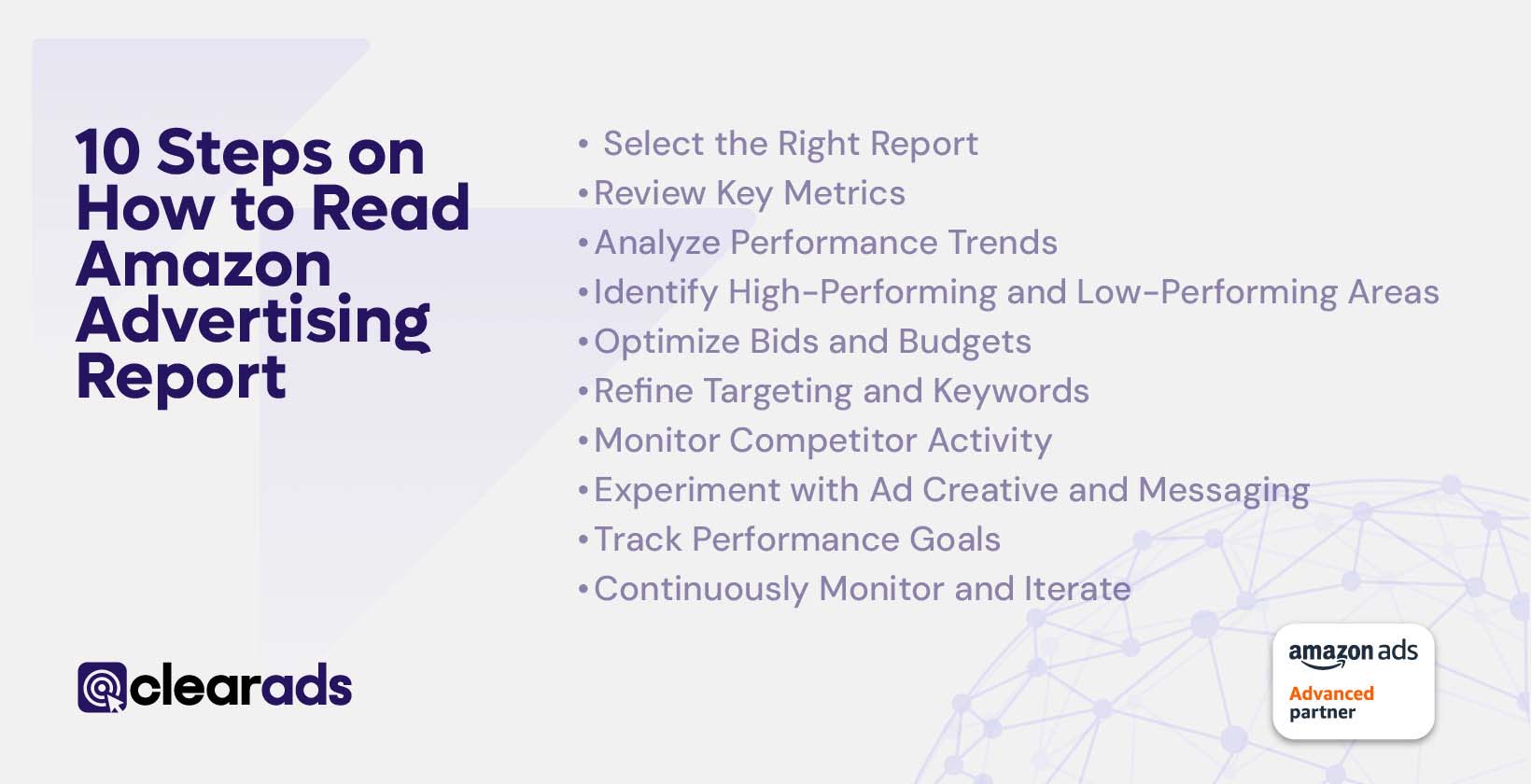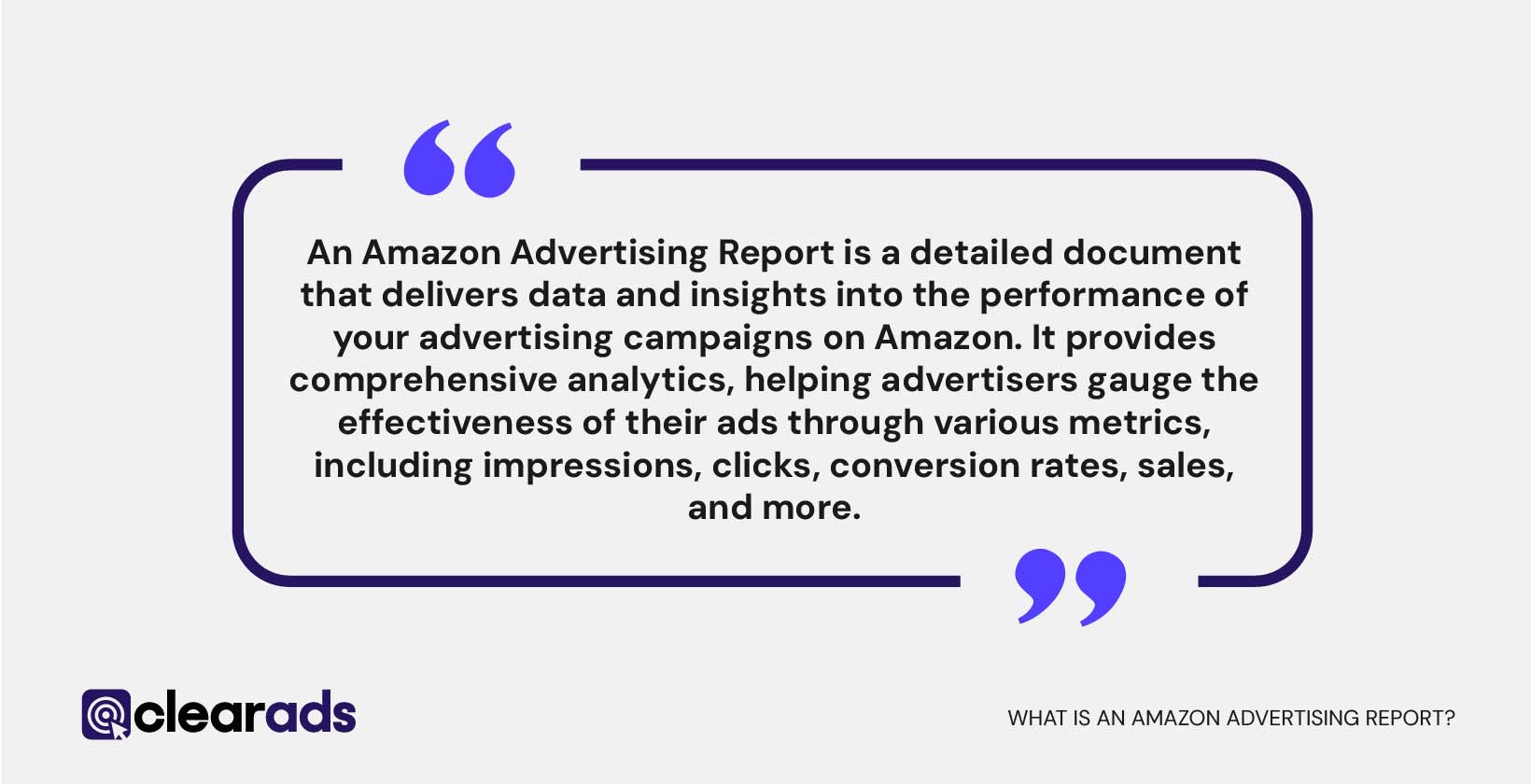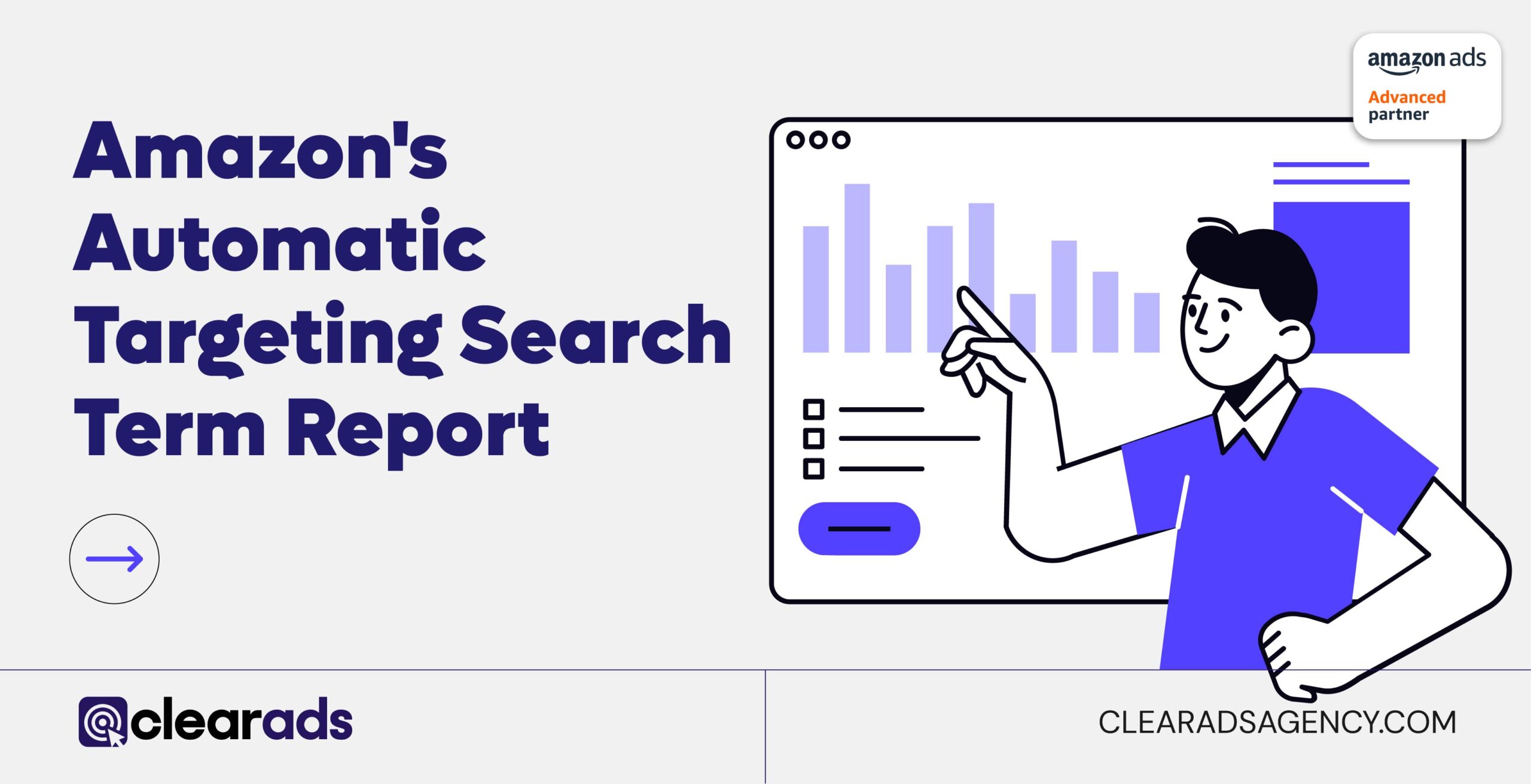Approximately 92% of buyers are more inclined to purchase products from Amazon than from other ecommerce platforms, underscoring the significant role of PPC ads on Amazon in influencing purchase decisions. Mastering Amazon Advertising Reports is crucial for marketers who aim to optimize their campaigns on one of the world’s leading retail platforms. These reports provide detailed insights into campaign performance, equipping advertisers with essential data for making strategic decisions that can significantly improve strategy and return on investment (ROI). By fully understanding each component of their campaigns, marketers can precisely adjust bids, targeting, and ad creatives, greatly enhancing campaign effectiveness.
The benefits of consistently monitoring and analyzing Amazon Advertising Reports are substantial, potentially improving ROI by up to 50%, increasing sales by 30%, and growing market share by 20%. These improvements demonstrate the profound impact that informed, analytical decision-making can have on the success of Amazon advertising efforts. Through detailed analytics, marketers can significantly enhance key performance metrics such as click-through rates, cost efficiency, and overall sales.
This guide outlines ten essential steps to effectively read and utilize Amazon Advertising Reports, ensuring that advertising efforts are optimized and yield the best possible outcomes. Learn how to monitor Amazon ads effectively, understand the nuances of Amazon reports, and leverage the full spectrum of data available to maximize visibility and drive sales.
10 Steps on How to Read Amazon Advertising Report

Navigating Amazon Advertising Reports efficiently is critical to optimizing your campaigns. Below, we outline the ten essential steps to grasp the full scope of your campaign’s data and leverage this information for strategic planning. These steps will be explained in detail in the following sections, providing a roadmap for a methodical enhancement of your advertising efforts on one of the world’s most influential retail platforms:
- Select the Right Report
- Review Key Metrics
- Analyze Performance Trends
- Identify High-Performing and Low-Performing Areas
- Optimize Bids and Budgets
- Refine Targeting and Keywords
- Monitor Competitor Activity
- Experiment with Ad Creative and Messaging
- Track Performance Goals
- Continuously Monitor and Iterate
Each step is designed to build upon the previous, culminating in a comprehensive strategy that enhances both the efficiency and effectiveness of your Amazon advertising campaigns.
1. Select the Right Report
Understanding Report Selection: Selecting the appropriate report in Amazon Advertising is pivotal for aligning data analysis with your specific advertising and business goals. Proper report selection refines insights to bolster informed decision-making and strategic development.
Performing Report Selection: Navigate through Amazon Seller Central to choose the right report by following these steps: go to ‘Reports’ > ‘Advertising Reports’. Here, you can create custom reports based on your campaign type, including Sponsored Products, Sponsored Brands, Sponsored Display. Each report type provides unique insights tailored to the specific advertising model. You can also access default campaign reports by navigating to Amazon Ads, then ‘Campaigns’. The default tab includes a variety of reports:
Performance by SKU/Product Report: Tracks product-specific performance.
Targeting Report/Search Term Insights: Provides performance insights based on search keywords or targets.
History Report: Documents changes made to campaigns, beneficial for teams managing multiple adjustments.
Importance of the Right Report: Choosing the correct report is crucial for acquiring relevant and actionable data, which assists in crafting strategies aligned directly with your campaign objectives.
Benefits of Accurate Report Selection:
Strategic Insights: Obtain clear insights into various aspects of your advertising strategy, enabling targeted improvements. For example, while some may seek to increase Return On Advertising Spend (ROAS), others might focus more on increased overall sales. Data and analysis should align with business objectives.
Enhanced Decision Making: Comprehend the effects of changes and performance trends across different campaign types to make data-driven decisions.
Competitive Analysis: Utilize the Insights and Planning tab, marked by an upward arrow icon, to access brand metrics and brand impression share data essential for evaluating your market position.
Additional Tools and Resources: The Amazon Ads section offers an extensive array of tools beyond report generation. Manage ads and oversee brand content, indicated by icons depicting a shield and heart, including crucial assets like store images. The Insights and Planning tab provides essential resources like brand metrics and brand impression share data, allowing you to benchmark against industry competitors and gauge if your products appear at the top of search results—a vital metric since the first page garners up to 95% of all search traffic.
By mastering these detailed reporting options and leveraging additional tools, advertisers can utilize a comprehensive toolkit that enhances campaign management, optimizes advertising spend, and aligns more effectively with overarching marketing and sales goals. This strategic approach ensures maximum visibility and more effective engagement with potential customers.
2. Review Key Metrics
Understanding Key Metric Review: These default metrics include impressions, clicks, spend, sales, budget, top-of-search, ROAS, and Advertising Cost of Sales (ACoS). Accessing these metrics is streamlined through the Amazon Ads dashboard, where they are prominently displayed for easy monitoring.
Performing Key Metric Review: The default campaign report provided by Amazon Advertising serves as a foundational tool for marketers, offering an exhaustive analysis of the performance of their advertising campaigns. This report compiles essential metrics, including impressions, clicks, spend, and sales, among others, into a comprehensive dashboard that provides a holistic view of campaign effectiveness. By systematically breaking down these metrics, the report enables marketers to assess the reach and impact of their ads, track budget utilization, and gauge the efficiency of their spending. This detailed visibility is crucial for identifying both high-performing aspects and areas needing improvement, allowing for precise strategic adjustments. Furthermore, the report facilitates trend analysis over various time frames, helping marketers understand the temporal dynamics of their campaigns and adjust their strategies in real-time to optimize campaign outcomes. Here’s a breakdown of the essential metrics:
Impressions: This metric tracks the number of times your ads are displayed, providing a basis for evaluating campaign reach and engagement effectiveness. High impressions indicate broad visibility, essential for brand awareness.
Clicks: Measures how often your ads are clicked. This metric is a direct indicator of ad appeal to the target audience.
Click-Through Rate (CTR): Represents the ratio of clicks to impressions, serving as an indicator of ad relevance and appeal. CTR is generally a better measure of success than clicks because it is an effectiveness measure. Typical CTRs for Amazon video ads range from 0.1% to 0.6%, varying by factors such as product category and audience targeting.
Spend: Shows the total amount spent on the campaign, crucial for budget management.
Cost Per Click (CPC): Displays the cost for each ad click. CPC values on Amazon can vary significantly, typically ranging from $0.02 to $3.00, with higher rates in competitive categories.
Sales: Indicates the revenue generated from the campaign, fundamental for evaluating the financial return on ad spend. The sales number represents sales only attributable to ad campaigns. Overall sales can be found in the business reports section.
Advertising Cost of Sales (ACoS): ACoS represents the ratio of ad spend to direct sales, expressed as a percentage. It is calculated using the formula: ACOS = (Ad Spend / Sales) x 100% For instance, if you spend $1,000 on an ad campaign that generates $3,000 in sales, the ACoS would be 33%. While an ACoS between 10% and 20% is generally considered favorable on Amazon, the optimal ACoS depends on specific business objectives and profit margins. A lower ACoS indicates efficient advertising spend relative to the revenue generated, suggesting a higher return on your advertising investment.
Return on Ad Spend (ROAS): Measures the total revenue generated for each dollar spent, often used to evaluate the efficiency of the advertising expenditure. It is calculated as (Revenue / Ad Spend).
Orders: Tracks the total number of orders (units sold) generated from the campaign, providing insight into conversion success.
Importance of Key Metrics: Monitoring key metrics is fundamental to gauging the operational health and efficacy of your Amazon advertising campaigns. These metrics serve as critical indicators that provide insights into the performance dynamics of your ads, from visibility through to conversion. By analyzing data such as impressions, clicks, spend, sales, and ACoS, advertisers can obtain a granular understanding of what drives campaign success or necessitates adjustments.
This ongoing evaluation helps identify trends, optimize strategies, and ensure resources are allocated efficiently, maximizing the impact of each ad dollar spent. Furthermore, understanding these metrics allows marketers to swiftly respond to changes in consumer behavior and market conditions, maintaining a competitive edge in a highly dynamic marketplace. This level of detailed oversight is indispensable for refining marketing approaches, improving return on investment (ROI), and achieving strategic business objectives.
Benefits of Reviewing Key Metrics:
Strategic Adjustment: Enables precise adjustments in campaign tactics based on performance data, such as refining bids or reallocating budgets.
Enhanced Budget Management: Efficient budget management through detailed tracking of sales, ACoS, CPC and overall spend.
Improved Campaign Effectiveness: A detailed metrics review helps enhance the overall effectiveness and ROI of campaigns.
Insights into Consumer Behavior: Provides insights into consumer behavior and ad engagement, which are pivotal for strategic marketing decisions.
By diligently reviewing these key metrics, advertisers can track the effectiveness of their campaigns and optimize them to achieve better reach and return on investment, ensuring each dollar spent maximizes business objectives.
3. Analyze Performance Trends
Understanding Performance Trend Analysis: Analyzing performance trends examines changes and patterns in campaign data over time. This analysis is essential for identifying effective strategies, recognizing those that are underperforming, and facilitating timely and necessary adjustments. Note that different Amazon advertising reports have different look-back windows. Some go back five years (default campaign reports), but some only go back 60 days (product trends report). Although most data can be found across multiple reports and is therefore available, if you know you will need YoY (year over year) data over a long time period, make sure you are saving key metrics in your internal databases.
Performing the Analysis: To thoroughly analyze performance trends, utilize the historical data available through the Amazon Ads dashboard. Examine trends in sales, ad spend, ACoS, and ROAS over various periods such as daily, weekly, monthly, or seasonally. For products with significant seasonal variance, compare data from equivalent periods across different years, like Black Friday of 2023 versus 2024. Assess any correlations between shifts in advertising tactics and changes in performance metrics to gauge the impact of your strategies.
Importance of Trend Analysis: Trend analysis is critical as it provides a predictive insight into future performance based on historical data. It reveals shifts in consumer behavior, the effectiveness of marketing strategies, and the influence of external factors like seasonal variations.
Benefits of Analyzing Performance Trends:
Forecast Future Trends: Anticipate changes in consumer behavior and market conditions, allowing you to stay ahead of the curve.
Optimize Budget Allocation: Adjust budgets towards more profitable periods or channels, leveraging insights gained from past performance.
Refine Marketing Strategies: Use historical data to improve marketing tactics, learning from past successes and failures.
This methodical approach to analyzing performance trends equips you to continuously refine and enhance your Amazon advertising campaigns, ensuring they are effectively aligned with your business objectives and adapt to changing market dynamics.
4. Identify High-Performing and Low-Performing Areas
Understanding Performance Variance: Effective resource allocation in Amazon advertising campaigns hinges on recognizing high-performing from low-performing areas. For example, a segment with high spend and minimal sales would be considered a low-performing area, indicative of poor return on investment. Similarly, an area that fails to generate sufficient impressions or clicks might also be underperforming, suggesting a need for better targeting or ad creative optimization. This process involves a detailed analysis across various campaign segments to determine which ones meet or exceed expectations and which ones falter.
Performing the Identification: To identify these areas, access your campaign data through the Amazon Ads dashboard. Segment the data by various criteria such as product lines, ad placements, or keywords. For instance, you might discover that Sponsored Brands campaigns underperform compared to Sponsored Products. Sponsored Brands are typically used for brand awareness with a broader reach, while Sponsored Products focus on specific products and are more conversion-oriented. Utilize the “brand metrics” feature on the main Seller Central dashboard for in-depth reports that can reveal detailed demographic insights. Analyze key performance metrics like conversion rates, Advertising Cost of Sales (ACoS), and Return on Ad Spend (ROAS) across these segments, identifying patterns of consistent over-performance or underperformance.
Moreover, you might find that video ads outperform standard image-based ads in certain categories. Video ads engage customers more effectively, leading to higher click-through rates and conversions. By comparing these different types of campaigns, advertisers can allocate resources more effectively, enhancing overall campaign ROI.
By systematically segmenting and analyzing these metrics, advertisers can effectively redirect their efforts and budgets toward the most lucrative areas, optimizing the overall effectiveness of their advertising strategy. This strategic approach ensures that resources are not wasted on underperforming segments, thereby maximizing the impact of every advertising dollar spent.
Importance of Identifying Variance: This analysis is crucial as it informs strategic adjustments in your campaign. Swiftly identifying underperforming areas allows you to mitigate losses by adjusting or discontinuing ineffective ads. Recognizing high-performing segments facilitates the replication of successful tactics and the scaling of profitable strategies.
Benefits of Performance Segmentation:
Optimize Ad Spend: Reallocate your budget from underperforming segments to those delivering higher returns, thus enhancing overall campaign ROI.
Tailor Marketing Strategies: Adapt your marketing efforts to capitalize on the strengths of high-performing areas while addressing the weaknesses of the less successful ones.
Improve Product Offerings: Leverage ad performance insights to refine your product offerings or promotional strategies, effectively targeting specific markets or segments.
By strategically focusing on high-performing areas and addressing or eliminating low performers, you ensure your Amazon advertising campaigns are cost-effective and well-aligned with your broader marketing objectives.
5. Optimize Bids and Budgets
Understanding Bid and Budget Optimization: Controlling costs and maximizing returns on Amazon advertising investments hinge on optimal bid and budget management. This involves adjusting your spending on ads and reallocating the budget across campaign elements based on performance evaluations.
Performing the Optimization: Analyze campaign performance data from the Amazon Ads dashboard, focusing on metrics like ACoS, ROAS, CPC, impressions, clicks, and sales. Assess which campaigns or keywords yield the highest returns and adjust bids upwards to increase exposure and organic positioning of high-performing keywords or downwards to reduce spending on less effective ones. Exercise caution with Amazon’s suggested bids, which provide insights into competitor bidding strategies but should be considered in context with your comprehensive data. Additionally, adjust your overall budget to prioritize campaigns that promote profitable growth. Modifying bids and budgets to align with peak seasons, product launches, or other significant events or competitor actions that could impact campaign dynamics is crucial.
Importance of Optimization: Efficient budget utilization enhances campaign profitability by allocating more resources to high-return keywords while reducing expenditure on underperforming areas.
Benefits of Bid and Budget Optimization:
Increase Campaign Effectiveness: Ensure funds are spent on ads that enhance sales, profitability and keyword organic positioning resulting in overall sales growth.
Maximize Financial Efficiency: Optimize resource allocation to boost advertising ROI, eliminating wasteful expenditure.
Adapt to Market Changes: Stay agile by adjusting bids and budgets in response to market fluctuations and consumer behavior changes, maintaining a competitive edge.
Continual refinement of bids and budgets, grounded in detailed performance analytics, dynamically improves the effectiveness of your Amazon advertising efforts, helping to maximize outcomes within allocated budgets.
6. Refine Targeting and Keywords
Understanding Keyword and Targeting Refinement: Enhancing the reach and efficacy of your Amazon advertising campaigns heavily relies on refining your targeting approach and keyword selection. This task involves recalibrating where and to whom your ads are displayed, guided by insights from historical campaign performance data. Additionally, analyzing market insights using Amazon tools such as Brand Analytics and Product Opportunity Explorer can significantly enhance the effectiveness of your campaigns. External tools like Helium 10, Jungle Scout, and Smart Scout also offer valuable data and analytics to aid in refining your Amazon advertising strategies, ensuring that your ads reach the most receptive audiences and yield optimal results.
Performing the Refinement: Start refining your targeting and keywords by delving into performance metrics available in the Amazon Ads dashboard. Access a detailed keyword report via Brands > Brand Analytics > Search Analytics > “Search Query Performance” on the main seller central dashboard. This report offers comprehensive insights into your campaign’s performance and your competitors’, including data like the average price of products purchased for specific search terms. Evaluate metrics such as total and brand-specific impressions, click rates, median price points, shipping speeds, cart add rates, and purchase rates to determine which keywords and targeting strategies are effective and which are not. Remove keywords that attract low-value shoppers and adjust bids on those that underperform. Also, consider removing keywords with high competition and high average CPC per purchase.
Importance of Refinement: Regular refinement of your targeting and keyword strategies is essential to align your advertising efforts with current consumer search behaviors and preferences. This proactive adjustment prevents wasteful spending on ineffective keywords and targeting approaches, enhancing the overall efficiency of your campaigns.
Benefits of Targeting and Keyword Refinement:
Enhanced Ad Relevance: Customizing your keyword list and targeting settings increases ad relevance, leading to higher engagement rates and improved conversion rates.
Increased Campaign Efficiency: Concentrating your budget on high-performing keywords and well-targeted audiences yields better results, potentially with the same or reduced ad spend.
Improved ROI: Ads that are more relevant and better targeted generally achieve higher conversion rates, offering a superior return on investment.
Adaptability: Ongoing updates and refinements to your targeting and keywords make your campaigns more adaptable and responsive to market trends and consumer behavior changes.
Consistently updating and refining targeting and keywords ensures that your Amazon advertising campaigns remain competitive, cost-effective, and capable of driving optimal outcomes, thereby maximizing your advertising investment.
7. Monitor Competitor Activity
Understanding Competitor Monitoring: Monitoring competitor activity is crucial for maintaining a competitive edge within Amazon’s marketplace. This involves observing and analyzing competitors’ advertising strategies, pricing, product listings, and overall market presence to stay abreast of industry movements.
Performing Competitor Monitoring: Effective competitor monitoring utilizes both Amazon Ads tools and additional third-party competitive analysis tools. Also, searching on Amazon as a fake customer will provide insight into how customers search for and view products in your category. These resources provide valuable insights into competitors’ top-selling products, pricing strategies, keyword usage, and advertising expenditures. It is vital to regularly assess their product reviews and ratings, note any updates to their listings, and track their responses to market trends and consumer demands.
Importance of Monitoring Competitors: Keeping tabs on your competitors helps you understand market dynamics and adapt your strategies to maintain or enhance your market position. It enables benchmarking against others in your category, identifies strategic gaps in your approach, and uncovers opportunities for differentiation.
Benefits of Competitor Monitoring:
Strategic Adjustments: Understanding competitors’ successful strategies allows you to fine-tune your product offerings, marketing tactics, and pricing strategies to better compete in the marketplace.
Proactive Market Positioning: By anticipating competitor moves, you can strategically position your products and marketing efforts to stay one step ahead, ensuring you maintain or even enhance your market share.
Opportunity Identification: Monitoring competitors helps you identify market gaps or customer needs that may have been overlooked. This insight can be pivotal in capturing new market segments and expanding your customer base.
Enhanced Market Understanding: Develop a deeper understanding of the competitive landscape, which is crucial for making informed strategic decisions that encompass product development and customer engagement.
Leveraging Market Dynamics: Monitor your competitors’ stock levels to potentially capitalize on any shortfalls. Tools like Helium 10’s Chrome extension can alert you when top sellers in your category are running low on FBA stock, presenting an opportunity for you to increase visibility and capture additional sales.
Analyzing Sales Trends: Utilize the Search Query Performance report to understand sales trends for specific keywords. This data allows you to compare your products’ performance and strategize accordingly to capitalize on traffic and sales growth opportunities.
Visibility into Sales Volumes: Recent updates now allow you to see the number of units sold for products exceeding 50 units per month on Amazon. This visibility into actual sales volumes can help refine your competitive strategy and inventory planning.
Regular monitoring of competitor activity is essential for competitive awareness and ensuring that your business remains adaptive and proactive in Amazon’s dynamic marketplace, thus supporting sustained growth and market presence.
8. Experiment with Ad Creative and Messaging
Understanding Ad Creative and Messaging Experiments: Experimentation with ad creative and messaging is pivotal for refining Amazon advertising campaigns, particularly within Sponsored Brand and Sponsored Display Ads. These ad formats allow marketers to test various creatives and messages to identify which elements most effectively engage and convert their target audience. For Sponsored Product Ads, Amazon generates ads using details from the main product image and title. Therefore, the only method to experiment with Sponsored Product ads involves making adjustments to the main image and title on the product listing itself.
Performing Experiments on Amazon: Navigate to Amazon Seller Central and select ‘Brands’ > ‘Manage Experiments.’ This area allows for controlled A/B testing of various advertising and product listing elements, providing a systematic approach to enhance ad performance.
Types of Experiments You Can Conduct on Amazon:
A/B Testing for Product Images and Titles: Evaluate different images and titles to determine which combinations yield higher views and conversions.
Content Experiments: Test variations in features, descriptions, and bullet points to identify content that improves information delivery and sales.
Pricing Experiments: Adjust pricing temporarily to discover price points that balance demand and revenue optimally.
Brand Messaging Tests: Experiment with various brand messages on product detail pages and across storefronts to gauge which narratives engage customers more effectively.
Importance of Experimentation: Regular experimentation is vital as it allows for continual refinement of advertising strategies based on real customer feedback, rather than assumptions.
Benefits of Ad Creative and Messaging Experiments:
Optimized Engagement: Determine which ad creatives and messages most effectively attract attention and stimulate action.
Increased Conversion Rates: Adjust your listings to better facilitate the customer journey from interest to purchase.
Data-Driven Decisions: Ground your marketing and product strategies in empirical data from direct customer interactions. You can take this data from areas such as the product reviews and the Q&A section of an Amazon listing.
Enhanced Customer Relevance: Keep your messaging and visuals timely and appealing, adapting to evolving consumer preferences and trends.
Discover the most effective strategies for engaging your Amazon audience through methodical experimentation with different aspects of advertisements and product listings, leading to enhanced marketing tactics and increased sales performance.
9. Track Performance Goals
Understanding Performance Goal Tracking: Monitoring performance goals is indispensable for assessing the success of Amazon advertising campaigns against set objectives. This process involves establishing specific, measurable goals as benchmarks for gauging the effectiveness of advertising strategies.
Implementing Goal Tracking: Initiate performance goal tracking by setting clear objectives, such as achieving a defined Advertising Cost of Sales (ACoS), reaching a specified sales volume, or attaining a targeted Return on Ad Spend (ROAS). Utilize the Amazon Ads dashboard to oversee these goals, configuring customized reports to regularly track progress and modify these reports as new data emerges and the campaign progresses.
Importance of Tracking Goals: Consistent evaluation of performance against established goals is critical as it provides definitive insight into the productivity of your advertising efforts. This regular monitoring aids in pinpointing areas requiring adjustments or further enhancements.
Benefits of Performance Goal Tracking:
Enhanced Strategic Focus: Ensures that advertising activities align with broader business aims, contributing effectively toward reaching these objectives.
Data-Driven Decisions: Supports informed decision-making with solid data, facilitating timely and strategic modifications.
Improved Resource Allocation: Promotes more efficient budget and resource distribution by identifying the most successful strategies and areas needing attention.
Motivation and Accountability: Establishes a framework for success, driving motivation and accountability within the team to meet set targets.
Through diligent tracking of performance goals, Amazon advertising campaigns can maintain effectiveness and adaptability to business objectives and market shifts. This continuous practice optimizes advertising expenditure, and fosters sustained business advancement.
10. Continuously Monitor and Iterate
Understanding Continuous Monitoring and Iteration: Continuously monitoring and iterating your Amazon advertising campaigns is crucial for maintaining their effectiveness over time. This process involves regular assessments of campaign performance and making adjustments based on these evaluations. To maintain a continuous improvement cycle, establish a routine for checking your campaign metrics frequently within the Amazon Ads dashboard. Use tools and reports that provide real-time data on various aspects of your campaigns such as impressions, clicks, conversion rates, and ACoS. It’s essential to also continuously monitor campaign budgets, bids, placement distribution, and the timing of ad distribution throughout the day. Additionally, keep a close eye on your share of voice, competitor pricing, new market entries, and promotional offers to ensure your campaigns remain competitive and effective. This continuous feedback loop allows for the agile adjustment of strategies to respond to market changes, consumer behavior shifts, or underperforming elements, optimizing your return on investment.
Implementing Continuous Monitoring: Establish a routine to frequently review campaign metrics within the Amazon Ads dashboard. It’s advisable to use tools that can alert you to significant changes on a daily basis, ensuring that you are always aware of any major shifts in campaign performance. Additionally, make it a practice to conduct a detailed check of your campaigns at least weekly. Utilize tools and reports that provide real-time data on impressions, clicks, conversion rates, and ACoS. This continuous monitoring allows for agile adjustments to your advertising strategies in response to market changes, shifts in consumer behavior, or underperforming elements, ensuring your campaigns remain optimized and effective.
Importance of Ongoing Iteration: The fast-paced nature of online markets, particularly on a competitive platform like Amazon, necessitates a proactive approach to campaign management. Regularly updating and monitoring your campaigns ensures they remain effective and yield optimal returns on investment.
Benefits of Continuous Monitoring and Iteration:
Agility in Strategy Adjustment: Enables rapid responses to shifts in consumer preferences or competitive dynamics, maintaining the relevance and competitiveness of your campaigns.
Optimization of Campaign Performance: Frequent adjustments based on up-to-the-minute data significantly boost the efficiency and efficacy of your advertising efforts.
Maximized ROAS: Continuous refinement of strategies ensures that each dollar spent is optimized for maximum return.
Enhanced Understanding of Market Dynamics: Persistent monitoring offers deeper insights into market trends and consumer behaviors, enhancing your overarching marketing strategy.
Embedding a culture of continuous monitoring and iterative adjustments within your Amazon advertising operations ensures sustained campaign performance and adaptability to market conditions, promoting ongoing business growth on Amazon.
Transitioning from campaign strategies to foundational knowledge, it’s crucial to understand the tools that drive decision-making in Amazon’s advertising landscape. Here we explore the core elements of Amazon Advertising Reports.
What Is an Amazon Advertising Report?

An Amazon Advertising Report is a detailed document that delivers data and insights into the performance of your advertising campaigns on Amazon. It provides comprehensive analytics, helping advertisers gauge the effectiveness of their ads through various metrics, including impressions, clicks, conversion rates, sales, and more.
How Are Amazon Ads Reports Generated?
Instruction List:
Log into Seller Central: Access your Amazon Seller Central account.
Navigate to the Advertising Console: From the main dashboard, select the ‘Advertising’ tab and then ‘Campaign Manager’.
Choose Report Type: Select the desired report type, such as campaigns reports, product reports, or targeting reports.
Customize Parameters: Specify the parameters for the report, including date range, campaigns, and any particular data points required.
Export Report: Click on ‘Export’ to download the data for team distribution.
How Is an Amazon Advertising Report Important?
Amazon Advertising Reports are indispensable for they provide actionable insights that empower advertisers to effectively optimize their campaigns. These reports are instrumental in identifying both high-performing and low-performing aspects of campaigns, facilitating targeted enhancements that can boost return on investment, amplify visibility, and increase sales.
What Do Amazon PPC Reports Contain?
Impressions: The number of times your ads were displayed.
Clicks: The count of times your ads were clicked by viewers.
Spend: The total amount spent on the campaign.
Sales: The revenue generated from the ad campaign.
ACoS (Advertising Cost of Sales): The percentage of direct sales generated from the ad spend.
CTR (Click-Through Rate): The ratio of clicks to impressions.
CPC (Cost Per Click): The average cost paid for each click.
Conversion Rate: The percentage of clicks that converted into sales.
These metrics are available for review by campaign name, ad group name, or specific ASIN or SKU level, providing a granular view of advertising performance.
When Should Changes Be Made to Amazon Ads?
Amazon ads should be changed when data shows underperformance or when external market conditions evolve. Proper timing for these adjustments is crucial and should be based on a thorough analysis of campaign reports that indicate a departure from established performance goals. Giving campaigns sufficient time to yield results is essential, as short-term fluctuations may not accurately reflect overall performance. Continuous comparison over time, against other campaigns, and across different products or with competitors will provide a comprehensive view.
Factors to Consider When Implementing Changes:
Performance Metrics: Adjust campaigns if key performance indicators like ACoS, conversion rates, or CTR are below expected thresholds or industry norms.
Market Trends: Respond to shifts in consumer behavior, seasonal demands, or competitor strategies to maintain a competitive edge.
Budget Considerations: Reevaluate your bid strategy or reallocate your budget if the current spending is not producing proportional returns.
Product Changes: Update your advertising strategies to reflect introductions of new products or modifications to existing ones to ensure alignment with their market positioning.
By considering these factors, advertisers can make informed decisions that optimize their Amazon advertising efforts and respond dynamically to changing market conditions.
Is PPC Better than Organic Performance?
Yes. PPC (Pay-Per-Click) advertising offers distinct advantages over organic strategies, though organic performance is essential for long-term brand recognition and customer trust. One critical component of an effective digital strategy is leveraging Amazon, which currently commands more than 12% of the entire US digital advertising market1. This significant share underscores Amazon’s growing influence and highlights the importance of optimizing Amazon PPC campaigns. Below are several reasons why PPC can be considered superior in certain contexts:
Kickstarting Visibility: PPC can rapidly enhance product visibility more quickly than organic methods, which is essential for new or lesser-known products.
Boosting Organic Ranking through Sales Velocity: Effective PPC campaigns boost sales velocity, enhancing organic rankings as Amazon’s algorithms favor products with higher sales figures.
Collecting Valuable Data: PPC provides immediate insights into customer behavior and keyword performance, allowing for faster and more informed marketing decisions.
Enhancing Product Reviews and Ratings: Increased sales through PPC often lead to more product reviews and ratings, benefiting both paid and organic performance.
Synergy Between PPC and Organic Growth: PPC drives initial awareness and purchases, potentially leading to organic repeat purchases and word-of-mouth referrals as customer familiarity and trust in the product increase.
Strategic Adjustments Based on Performance: PPC offers the flexibility to quickly test different marketing messages and target various customer segments, facilitating swift strategic modifications based on real-time data.
PPC is invaluable for maximizing visibility and expediting market entry, particularly valuable in highly competitive markets. It complements and enhances organic growth strategies by allowing brands to target and capture market share aggressively.
Concluding Insights on Amazon Advertising Reports
Mastering Amazon Advertising Reports is crucial for advertisers aiming to refine their campaign strategies and enhance decision-making processes. Effective selection and analysis of the right reports and diligent review of key metrics allow for a deep understanding of campaign dynamics. Advertisers can significantly elevate their campaign effectiveness by analyzing performance trends, pinpointing high-performing and underperforming areas, optimizing bids and budgets, and continuously monitoring market and competitor activities. This meticulous approach fosters a comprehensive grasp of advertising efficacy and market dynamics, enabling more precise decisions and optimal resource allocation. Through these practices, advertisers achieve improved campaign results and enhance their strategic capabilities within the competitive Amazon marketplace.





